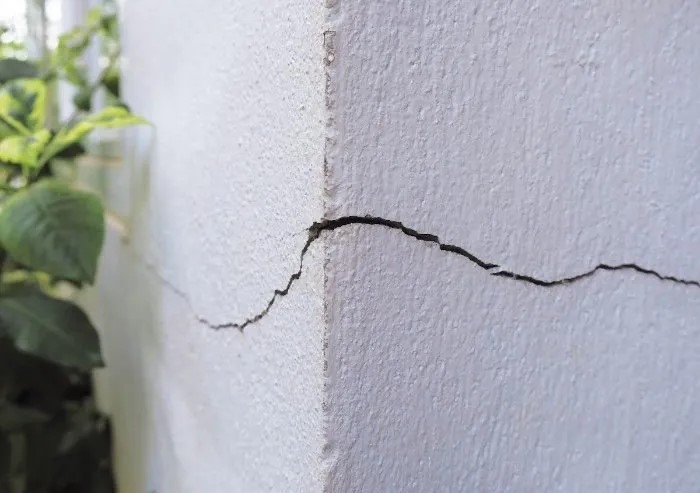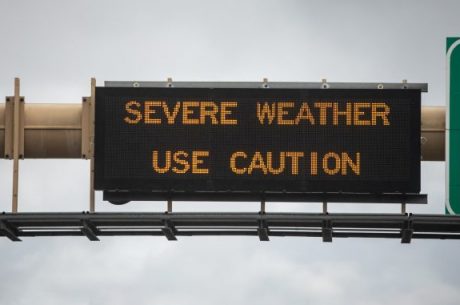Seeing some water on your concrete floor might seem like a trivial matter. You might even dismiss the sight, thinking it will dry and not cause a problem. However, you may be surprised to learn that water-damaged concrete can be one of the most devastating problems a homeowner or business owner can face. Not only is it unsightly, but it can also cause structural issues and mold growth if not addressed properly.
In this blog, we’ll examine how significantly concrete can be damaged by water and what you can do to repair it.
Potential Causes of Water-Damaged Concrete
Several elements can cause water damage to concrete. The most frequent culprit is a lack of proper waterproofing, which can affect the structural integrity of the surrounding concrete, causing water damage to any existing concrete.
Tree root growth and seismic soil movement can contribute to water-related damage in concrete structures. Settlement cracks can lead to water entering the dense material, affecting its integrity and causing it to degrade over time.
Plumbing leaks can also cause major damage to a concrete foundation. Leaking pipes left unchecked can weaken the integrity of the surrounding concrete over time, eventually leading to a cracked and crumbling surface. Pooling water from a plumbing leak may seep into the pores of the concrete, creating further erosion over time and resulting in an uneven floor.
In addition, concrete flooring is more likely to have residual water damage due to its porous nature. This issue is common in basements and crawl spaces, which are often built from a concrete foundation.
This is especially relevant to homes and commercial buildings across Suffolk and Nassau County, NY, where many properties include finished basements and below-grade areas prone to moisture intrusion due to high water tables and seasonal humidity.
Water damage to concrete significantly impacts the strength of the material. When too much water enters the concrete grains, it causes them to spread apart and develop cracks, thus creating more space between them. Even after the water dries, these gaps remain and are filled with air, which lessens the durability of the concrete.
It’s also common for mold spores to grow within the cement, as a dark and moist crack can provide a perfect breeding ground for spores to grow and spread.
Many homes are built on concrete foundations, and a combination of these things can lead to a dangerous living scenario. Homeowners should take preventative measures by ensuring their homes are waterproofed to reduce and prevent further water damage to concrete.

How to Identify If Cement is Wet
A visual inspection is one of the most basic ways of telling if the concrete is wet or dry. You can do this by looking at the surface of the concrete: if it’s relatively glossy and has a sheen, it’s likely wet. If it’s dry, you’ll be able to tell because it will appear duller and lighter in color.
Another way to check is by testing its firmness. Try pressing your finger into the concrete and seeing how easily it pierces through. If it’s still too firm, then it’s likely still wet.
For more accurate results, consider purchasing a moisture meter. These meters measure the amount of moisture in materials like wood and cement. Insert two pins into your material and read the percentage value displayed on the screen; anything above 10 percent indicates moisture in your material. Remember that different types of meters have different thresholds, so ensure you get one that meets your needs accordingly.

For more accurate results, consider purchasing a moisture meter. These meters measure the amount of moisture in materials like wood and cement. Insert two pins into your material and read the percentage value displayed on the screen; anything above 10 percent indicates moisture in your material. Remember that different types of meters have different thresholds, so ensure you get one that meets your needs accordingly.
Common Issues with Drying Concrete Floors
1. Porosity of Concrete
Concrete is a porous material, which means it can absorb and retain a significant amount of water. The water doesn’t just sit on the surface; it penetrates deep into the concrete, making it difficult to extract all the moisture quickly. This deep absorption can prolong the drying process and complicate efforts to ensure the floor is completely dry.
2. Slow Evaporation Rate
Because of its dense structure, concrete releases moisture slowly. Unlike more permeable materials such as wood or drywall, concrete does not allow water to evaporate quickly. This slow evaporation rate can lead to prolonged periods of dampness, increasing the risk of mold growth and further damage to the floor and any materials installed on top of it.
3. False Sense of Dryness
Concrete can feel dry to the touch on the surface while still retaining significant moisture within its structure. This false sense of dryness can mislead contractors and property owners into thinking the floor is ready for new coverings. However, the residual moisture can cause problems later, such as the failure of adhesives and the development of mold under the flooring.
4. Impact on Subsequent Flooring Installations
When new flooring is installed over inadequately dried concrete, several issues can arise:
- Adhesive Failure
- Warping and Cupping
- Mold and Mildew
5. Misdiagnosis of Problems
When issues arise with newly installed flooring, the initial reaction is often to blame the flooring material or the installation process. However, the root cause is frequently the undried concrete beneath. Misdiagnosing the problem can lead to repeated failures and increased costs as new flooring is installed without addressing the underlying moisture issue.
6. Challenges with Moisture Testing
Accurately testing the moisture content in concrete can be challenging. Standard moisture meters may not provide a complete picture of the moisture levels deep within the concrete. More advanced tools and techniques, such as relative humidity testing using in-situ probes, are often required to get an accurate assessment. However, these methods are not always used, leading to incorrect conclusions about the dryness of the concrete.
7. Environmental Factors
Environmental conditions such as temperature, humidity, and airflow can significantly impact the drying process. High humidity levels in the surrounding environment can slow down the evaporation of moisture from the concrete. Similarly, insufficient airflow can prevent moisture from escaping efficiently, prolonging the drying process.
This is particularly important in Long Island’s climate, where seasonal changes and coastal weather patterns can affect the indoor humidity levels. Homeowners and business owners in Suffolk and Nassau counties must account for these fluctuations when drying out water-damaged concrete.
How to Deal With Water-Damaged Concrete
The first step to addressing water damage to concrete is to identify the source of the problem. It could be a leaking roof, plumbing issue, or flooding from a nearby river or lake.
Once you have identified the source of the water damage, it’s important to take steps to stop it from happening again. If the source is a leaking roof, you’ll need to make repairs or replace the roof altogether. You can contact a professional plumber to find and fix the plumbing issues.
In the event of a flood caused by heavy rain or any other natural disaster, you might need to contact a property restoration company like PuroClean to remove standing water and check the moisture levels. A restoration company might also be able to inform you of any potential mold issues since water damage within concrete can lead to excessive mold growth.
Residents in Long Island often face coastal storms and heavy rain events that can overwhelm local drainage systems. That’s why it’s crucial to act swiftly and partner with local restoration experts familiar with the unique environmental challenges in our area.

How Professionals Dry Water-Damaged Concrete Floors
1. Assessment and Inspection
2. Containment Chambers
3. Dehumidification
4. Air Movement
5. Monitoring and Adjustments
6. Final Moisture Testing
7. Consultation on Flooring Installation
Professionals serving Suffolk and Nassau County understand the intricacies of older and newer construction common in our neighborhoods—from historical homes in Huntington Village to newly built residences in Massapequa. That local expertise helps ensure a more tailored drying approach that suits the construction and climate conditions of the region.
How to Repair Damaged Concrete
After identifying and fixing the source of water damage, you’ll need to repair the concrete itself. Depending on the severity of the damage, you may need to patch or replace the concrete. If you decide to fix the work, consider wearing personal protective equipment (PPE) since it can get messy.
Patching is usually used for minor cracks and holes, while a complete replacement of the concrete might be necessary if it’s crumbling or flaking away. You’ll also want to consider sealing your concrete after repairs to protect it from future water damage.
The first step in repairing wet concrete is to clean the area. Make sure that you remove any dirt or debris and standing water that may be present. If there are any large pieces of debris, such as stones or rocks, you should use a shovel or brush to remove them.
Once all the debris has been removed, you may use a garden hose to rinse any remaining dirt or dust particles. Allow the area time to dry completely before proceeding.
Once the area has been cleaned and dried, use a putty knife or trowel to scrape any loose concrete slabs from the affected area. Once all loose material has been removed, you may use a wire brush or grinder to smooth out any bumps or imperfections on the surface.
Mix your mortar according to manufacturer instructions and apply it liberally over the affected area using a trowel or putty knife. Work in small sections so that your mortar does not dry before you have had a chance to spread it evenly over your work surface. Then allow your mortar mix to dry and cure for 24-48 hours.
After any concrete foundation has been repaired and sealed, it’s important to inspect the area regularly for signs of any further damage. If you find any leaks or pooling of water, address them immediately before more extensive damage can occur. Regular maintenance and proper care ensure that your concrete remains safe and sound for years.

Mix your mortar according to manufacturer instructions and apply it liberally over the affected area using a trowel or putty knife. Work in small sections so that your mortar does not dry before you have had a chance to spread it evenly over your work surface. Then allow your mortar mix to dry and cure for 24-48 hours.
After any concrete foundation has been repaired and sealed, it’s important to inspect the area regularly for signs of any further damage. If you find any leaks or pooling of water, address them immediately before more extensive damage can occur. Regular maintenance and proper care ensure that your concrete remains safe and sound for years.
If You Are Experiencing Water Damage, Contact PuroClean of Huntington
Water damage can be a stressful and overwhelming experience, especially when it affects the foundation of your home or business. That’s why the trusted team at PuroClean of Huntington is here to help.
We specialize in drying and restoring water-damaged concrete and foundations.
We understand the unique environmental challenges in Suffolk and Nassau County.
We use advanced moisture detection and drying equipment for fast, thorough results.
Whether you’re dealing with a basement leak in Commack, flood damage in Huntington Station, or excess moisture in a commercial space in Melville, our certified professionals will respond quickly and work efficiently to restore your property. Call us at (631) 402-9700 or visit our website today. Let PuroClean of Huntington be your trusted partner in property restoration.




 PuroClean of Huntington
PuroClean of Huntington